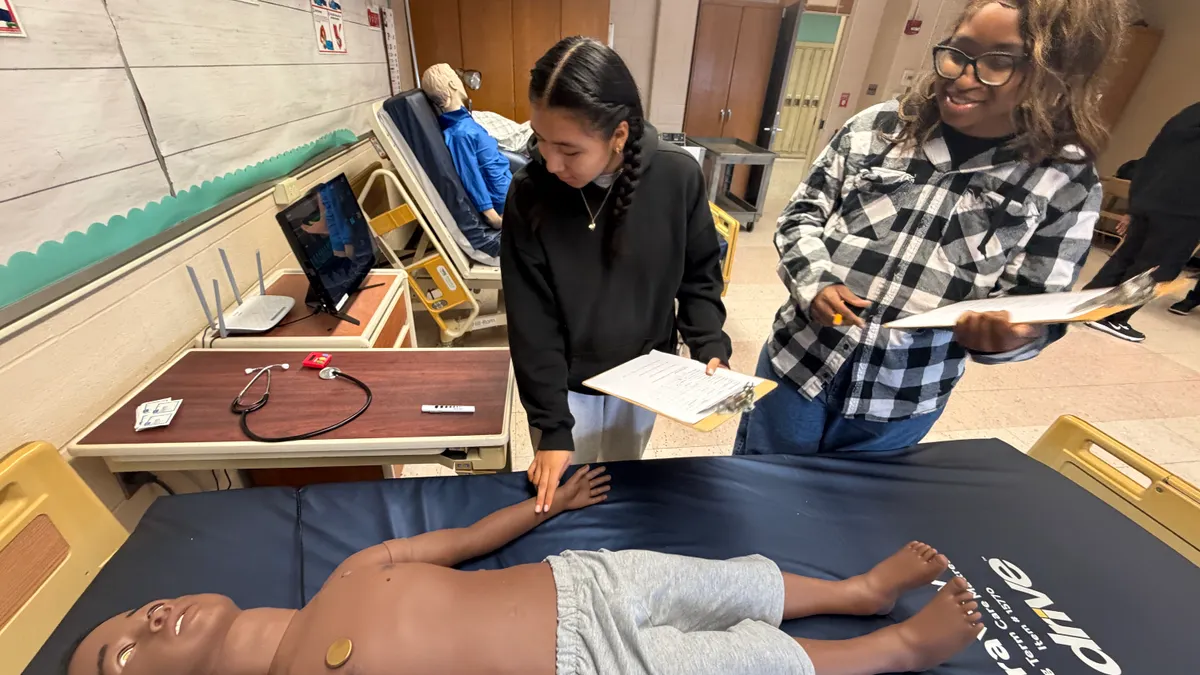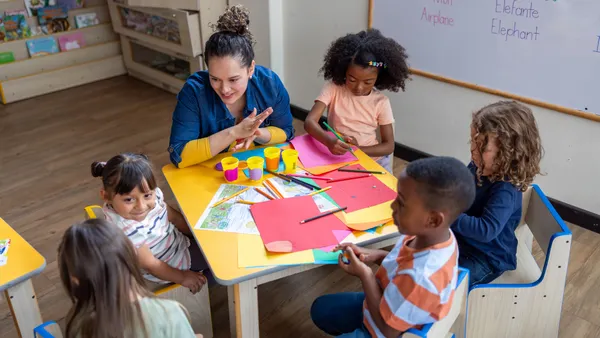When New Jersey's Highland Park School District joined a pilot program during the 2019-20 school year designed to weave LGBT curriculum into classrooms, Superintendent Scott Taylor quickly heard from teachers who felt they needed support on how to respond to parents, guardians and even students who have concerns about the new curriculum.
His response? Taylor invited everyone to come talk with him.
“I held a forum for anybody in the district community who wanted to come, to learn about the initiative and to express concerns,” he told K-12 Dive. “It was co-hosted by me and members of Garden State Equality. And I also encouraged teachers to refer any student, parent or guardian that had a question that they couldn’t address, to come to me personally.”
New Jersey is one of five states including California, Illinois, Oregon and Colorado with mandates for public schools to teach LGBT-inclusive curriculum, which varies from the roles and contributions of LGBT figures in history to sex education. Yet experts say there is very little to enforce these requirements, whether that’s districts implementing the curriculum to teachers using it in their classrooms.
“I try to tell them you are mandated to teach it, and we can help you so that you do the best job possible, but after that we have no power to make them do it,” said Ron Indra, director of Safe Schools Project, an organization focused on LGBT inclusivity in education, and a former high school social studies teacher in Santa Cruz, California. “There really is no punishment even if they’re not.”
But there are steps educators and district leaders are taking to support teachers and districts, as well as families, to ensure LGBT-inclusive learning is adopted into curricula and brought to all students.
Addressing pushback from the community
After the forum Taylor held in his district, he did not hear from teachers with additional questions. Families were another matter, with some meeting with him in his office to address concerns including beliefs the new curriculum would not support their religious views.
“Another said to me, ‘I feel like you’re giving my child too many choices about sexual orientation,’” he recalled. “I offered them my ear in listening. But I didn’t offer them anything else.”
Tray Robinson, a special education high school teacher in San Jose, California, said pushback to supporting LGBT-inclusive curriculum from families or people in the community can take indirect forms, as well — not necessarily a formal request to meet with a district superintendent. Robinson, GLSEN’s 2020 Educator of the Year, has found things parents say at home may make it difficult for educators teaching LGBT-inclusive curriculum in the classroom.
“Pushback comes in the form of parents who won’t use your pronouns, or tell their kids there is another pronoun to use for you, or tell their kids there are only two pronouns,” said Robinson. “Even if they do not mean it to be malicious, it is what they believe.”
Some strategies administrators and educators can use to defuse situations when they get pushback from parents include offering a toolTaylor employed: inviting parents into a conversation and allowing them to be heard. But Taylor was also clear to families that the rollout would continue.
Robinson also notes districts can take steps to help not only educate families, but students as well. That can include a school having an identified point person to address and facilitate LGBTQ questions and pushback on campus, adding lessons into the curriculum, and “teaching that there are different genders and pronouns, and about tolerance and anti-bullying,” he said.
Additionally, Robinson believes in what he sees as humanizing a situation — that by building strong relationships with students, you can help them understand what they may be saying or doing to others is hurtful.
“Using those relationships, and explaining that who you are and how people talk about you matters and can hurt, is something kids understand,” he said.
Dealing with opposition from educators
Resistance can occur within school buildings, as well. Some teachers, Indra said, will say they don’t have time to bring additional lessons into their existing educational plans when asked to adopt LGBT-inclusive curricula. While the Safe Schools Project offers districts curriculum guides written by educators on its staff and also makes its staff available for in-service support to districts and teachers, educators will still decline.
Even if a district does choose to work with an organization like Safe Schools Project, he said, teachers cannot be forced to attend professional development sessions, even though districts typically pay for them.
“[Educators] say to me, ‘I already have a lot of history to teach,’” he said. “And even though we’ve given them lesson plans and resources, they’ll say it’s one more thing that they have to do and put into place. Also, a teacher or a district may also be conservative, and so we can get pushback from that [point], as well.”
Curriculum designers and administrators can support teachers by adopting material from groups like Safe Schools Project, which has well-researched materials already developed that can be folded quickly into place. They can also point to individual lesson plans and activities that can be added to existing curricula.
Facing History and Ourselves, for example, has activities and PDFs of LGBTQ History Cards that can be printed by teachers and used in social studies, science, English literature and history courses to cover prominent historical figures like former San Francisco politician Harvey Milk, author James Baldwin, Hawaii politician Kim Coco Iwamoto and civil rights activist Bayard Rustin, a key organizer for the March on Washington.
Taylor also believes it can be helpful for administrators to also add accountability measures into any implementation happening districtwide. In that way, they can be assured rollout of a new curriculum is reaching all students.
“Principals and curriculum leaders, when checking lessons plans, can verify that each teacher for whom they’re responsible for supervising has included some aspect of the initiative in their lessons,” he said.
Supporting teachers who adopt inclusive curricula
When teachers do take advantage of information, lessons and steps offered to them, there is a better chance they'll be able to add LGBT-inclusive curricula into lesson plans, said Sara Staley, co-founder and co-director of A Queer Endeavor, a University of Colorado Boulder’s School of Education program centered around gender and sexual diversity in education.
Staley, an assistant professor of teacher learning, research and practice and a former classroom teacher, worked with teachers in the Boulder Valley School District to help them understand what LGBT students can experience in schools. She then walked them through steps educators can take in classrooms to support these young people. The group also worked to develop LGBT-inclusive lessons and curricula.
“Our sense is that teachers want to do right by LGBTQ+ youth, but they need help and access to professional development,” Staley told K-12 Dive via email. “Once teachers gained that access in BVSD, so many of them immediately put their learning to work through practice.”
Taylor said the same thing about Highland Park School District. “Professional development is the most important piece of this whole puzzle because teachers needs to have confidence weaving LGBTQ-related learning into their classrooms so that it’s not just an add-on,” he said.
Educator support is also a crucial reason why Indra and the Safe Schools Project continue to reach out to districts across California, to assist educators so they can bring LGBT-inclusive curriculum into their classrooms and to support students, as well.
“It’s a slow process, he said. “And we do it step by step.”
















